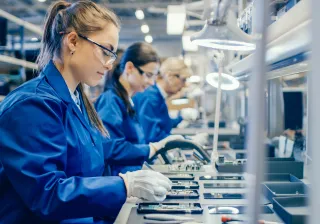Digital technology experiments and development will make the factories and production facilities of tomorrow look very different from those we know today.
The manufacturing industry still has a lot of old infrastructure and practices, but rapid advancements in technology are opening up a multitude of new opportunities for modernisation in Finnish industry. Currently, research institutions and businesses are looking at the benefits to be gained for instance through robotics, additive manufacturing (e.g. 3D printing) and digital technologies and platforms for modernising production and improving competitiveness in the future.
- Robots will not replace people: they will support people in their work. Human-robot collaboration will be the big change that will happen in the 2030s, says Research Manager Riikka Virkkunen at VTT.
The role of humans in industry will change to that of experts, meaning design and supervision as automation and robotics develop to a point where production robots are sophisticated enough to update themselves and entire plants can be run by remote control.
New opportunities for networking
Digital data platforms also offer businesses new opportunities for networking.
- Enhanced data collecting and sharing can help adapt production better to the anticipated level of orders or customise it efficiently according to increasingly individual needs of customers or end users, says Virkkunen.
This is particularly important for Finnish businesses, which are typically highly specialised and make products in small quantities. Also, data platforms allow closer contact with partners, customers and other businesses, and this in turn allows services to become more efficient and to grow.
Virkkunen names the embracing of digitalisation and innovations as the killer competitive advantage for Finnish industry in the future.
- There is a will to go ahead with this change, but we need more large companies on board, because they have more muscle than SMEs to invest and experiment, and they also have the potential for integrating agile small businesses into the process.
Indeed, many large companies are already sitting up and taking notice: data analysis is widely used in the metal and paper industries for optimising production, improving production quality and enhancing situational awareness.
Circular economy brings further challenges
The circular economy will bring businesses further challenges going forward. Material identification, collection and recycling will demand a lot, but production will also need to be overhauled to deal with using recycled materials or products as raw material, for instance. Virkkunen notes that industrialising the innovations of the circular economy is one of the greatest challenges and opportunities of the near future.
- We aim to design smarter, new solutions that are consistent with sustainable development and that will be produced efficiently using processes that do not yet exist. This represents a huge challenge for VTT.






